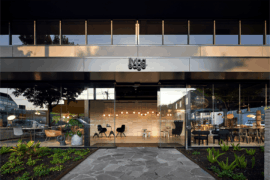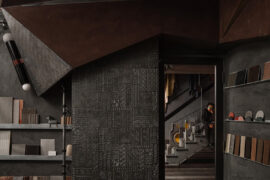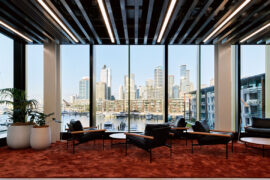Knoll’s revolutionary legacy, from its pioneering mid-century modern origins to its current place within the MillerKnoll collective, continues to shape the spaces we inhabit. Here, we explore the iconic institutions, influential collaborations, and groundbreaking ideas that have shaped Knoll’s unique understanding of the human-space connection — the bedrock of the brand’s enduring relevance.

November 14th, 2024
Nothing exists in isolation. The interplay of interactions and influences, no matter how fleeting, yields an intricate fabric of interconnectedness that governs the human experience. After all, it is in recognising these connections and confluences that we find meaning, purpose, and the very essence of creativity. In its purest form, design is the most radical expression of this truth. Galvanised by the dynamic multiverse of people, places, concepts and experiences, both past and present, the very act of creation converges all that’s come before it with what’s yet come in the pursuit of relevance that resonates, endures and transforms.
Knoll, a renowned design brand born from the dynamic confluence of visionary minds and groundbreaking ideas, embodies this idea. Founded in 1938 on the wave of modernist ideals arriving from Europe, the company set out to revolutionise the way people experience the spaces they inhabit. Now, as a founding member of the MillerKnoll design collective established in 2021, the American manufacturer of furniture and office systems continues to yield unwavering relevance, creating designs that bring a sense of functional harmony to the architecture they occupy.

Here, we trace the invaluable connections between places, people, and concepts that set Knoll’s dynamic design universe in motion and continue reverberating through every aspect of their design process. From the prolific intersection of iconic design schools and the pioneering confluence of architecture and furniture design to the collaborative exchange of ideas and life-long creative partnerships, we unravel the intricate tapestry of Knoll’s design heritage, beginning with the key figures who started it all.
The intersection of Bauhaus’ rigour with Cranbrook’s ingenuity
In the early 20th century, two legendary design schools, the Bauhaus and Cranbrook Academy of Art, emerged as breeding grounds for some of the world’s most influential design luminaries.
Founded by Walter Gropius in Germany in 1919, the Bauhaus championed the merging of art, design, and industry, a revolutionary idea that Gropius and designer Marcel Breuer brought to the United States in 1930. Their Minneapolis office was where the young architecture student Florence Knoll – Schust at the time – landed a particularly significant internship.

A pivotal figure in shaping Knoll’s design philosophy, Florence was first introduced to the Bauhaus school of thought by her mentor and head of the architecture department at the Illinois Institute of Technology, Ludwig Mies van der Rohe, who was also the director of the Bauhaus for more than a decade. This exceptional team of thought leaders instilled in Knoll the conviction that design isn’t the creation of single objects but rather a holistic spatial approach that considers the interplay between people, objects, and architecture.
The ideas that would later form a foundation for Florence’s lifelong commitment to the principles of total design were also reinforced by Eliel Saarinen, the founder of the Cranbrook Academy of Art in Michigan, who taught his students that furniture should be designed to complement architecture, rather than compete with it.

Envisioned as a “working place for creative people” and widely considered as “America’s Bauhaus”, Cranbrook was an immersive environment that fostered generous exchange of thought, creative connection and unbound experimentation. It’s amidst this invigorating community that Florence – alongside fellow design luminaires like Eero Saarinen, Harry Bertoia, and Charles and Ray Eames – honed her skills and forged bonds that would lead to life-long creative collaborations that influenced the design landscape at large.
The meeting of minds
Among these pivotal relationships, the one with Hans Knoll was one of particularly momentous significance. The couple first met right after Florence arrived in New York, and the design prodigy immediately connected with the young German businessman who had recently founded a furniture company.
Following his father’s footsteps, Hans sought to bring the modernist vision championed by the Bauhaus trailblazers to the US, and H.G. Knoll Furniture Company was a direct reflection of this mission. First established as an importer of modern furniture, the company became one of the world’s most formative and prolific design brands under Florence and Hans’ progressive leadership.

The innovative business embraced the creative ideals of the Bauhaus and Cranbrook, and its dynamic evolution was punctuated by the concepts, relationships and collaborations formed during those earlier years. Some of the most acclaimed pieces in the Knoll portfolio – like the iconic Barcelona Chair and the Wassily Chair – were designed by Knoll’s Bauhaus mentors, Mies van der Rohe and Breuer, respectively. Similarly, some of the most coveted furniture collections in the world – including Eero Saarinen’s Pedestal Collection or Womb Chair and Harry Bertoia’s wire seating collection – evolved from the designers’ Cranbrook studies in sculpture.
The juncture of architecture and furniture design
But the Bauhaus and Cranbrook influences didn’t end there. The powerful concept of total design – or total architecture – that Florence first learnt about as a student emerged as a pivotal influence that informed Knoll’s distinct relationship with spatial planning.
Committed to the pioneering concept that considered the unavoidable interplay between people, objects, and architecture propelled Florence to infuse Knoll with a modernist and practical dedication to harmonious and functional spaces. So much so that, while so many of her designs have gained the status of modernist icons, she considered herself a problem solver rather than a furniture designer.

“I never really sat down and designed furniture,” she famously said. “I designed the fill-in pieces that no one else was doing. I designed sofas because no one was designing sofas.” In fact, she often referred to her designs as “meat and potatoes,” intended to perform supporting roles for the works of Eero Saarinen, Harry Bertoia, and Ludwig Mies van der Rohe released as part of Knoll’s collection.
The convergence of the visionary and pragmatic
While the inventive designer might have considered her furniture pieces somewhat secondary, Knoll’s trailblazing Planning Unit was utterly unprecedented. Founded in 1946, the unit made Knoll the first furniture company to have a planning department.
With meticulous research and surveys, Florence delved into the intricacies of each client’s needs, studying their patterns of space utilisation and the dynamics of their company hierarchies. This rigorous process was the foundation for her comprehensive designs, often solving office problems that hadn’t been recognised before. Her insights and expertise, incredible instinct, and pioneering approach, which considered the space as a whole, explain why many of her works began as bespoke solutions and were later incorporated into the Knoll brochures.

“The spaces suggest the furniture,” Vincent Cafiero, an early member of the Planning Unit, once said. “And sometimes that furniture was not in our catalogue.”
This anecdote highlights Florence’s visionary leadership, during which the Planning Unit revolutionised the American business environment. She introduced modern concepts of efficiency, space planning, and comprehensive design to interiors and defined the standard for the contemporary corporate office of post-war America, including IBM and General Motors.
The synthesis of past, present and future
After Hans’ passing in 1955, Florence continued to lead the company for over a decade. And even though she retired in 1965, her immense contributions to Knoll, the office landscape, and the rise of modernism in America continue to inspire, inform and affect the realm of design on a global scale. Her influence was encapsulated by a 1964 New York Times profile that declared her the woman who led the office revolution and the “single most powerful figure in the field of modern design.”
It’s this remarkable legacy of a pioneer driven by a profound understanding of human interaction with space that continues to underpin Knoll’s design ethos to this day. It’s Hans Knoll’s charismatic resolve to popularise modernist aesthetic that keeps galvanising Knoll’s international significance. It’s the transformative power of creative collaborations that has powered Knoll’s partnerships with some of the most renowned designers, like Piero Lissoni and Antonio Citterio. Finally, it’s the enduring creative connection, born at the prolific intersection of Bauhaus and Cranbrook, that is once again realised in Knoll and Herman Miller’s coming together to create the MillerKnoll collective.

Today, as an integral part of this global design powerhouse, Knoll’s affinity for human-centric design remains a timeless touchstone, preserving the past and actively shaping a future where spaces foster genuine connection. This enduring commitment to furniture design that harmonises with the totality of a space stands as a tribute to Florence Knoll’s revolutionary vision, reflecting a profound understanding that exceptional design, like life itself, never exists in isolation and that everything is inherently, irrevocably, and totally connected.
Designers throughout Australia, New Zealand, and Asia can experience this legacy of timeless design and harmonious functionality firsthand. Locate your nearest MillerKnoll dealer and elevate your next project with Knoll’s iconic collection.
INDESIGN is on instagram
Follow @indesignlive
A searchable and comprehensive guide for specifying leading products and their suppliers
Keep up to date with the latest and greatest from our industry BFF's!

For Aidan Mawhinney, the secret ingredient to Living Edge’s success “comes down to people, product and place.” As the brand celebrates a significant 25-year milestone, it’s that commitment to authentic, sustainable design – and the people behind it all – that continues to anchor its legacy.

From the spark of an idea on the page to the launch of new pieces in a showroom is a journey every aspiring industrial and furnishing designer imagines making.

Bangalore studio Multitude of Sins elevates true leftovers — not surplus — into a richly layered workspace where waste materials become narrative, structure and sculptural expression.
The internet never sleeps! Here's the stuff you might have missed

Through expert architecture, EBD Architects has provided a human face to great design and created a project that enhances the lives of people and community.

Warren and Mahoney’s design for Beca’s Auckland headquarters turns the mechanics of engineering into poetry, rethinking how workplace design can reveal its own systems.